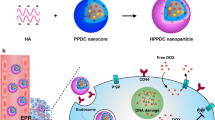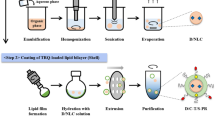Abstract
In this study, nano-strategy for combined medication of active compounds from traditional Chinese medicine herbs was proposed to achieve the synergistic effects of inhibiting the doxorubicin (DOX) resistance, reducing the cardio-toxicity, and improving the treatment efficacy simultaneously. Dihydroartemisinin (DHA) and tetrandrine (TET) were co-delivered for the first time to treat DOX resistance of breast cancer with multi-pathway mechanism. Tumor micro-environment sensitivity prescription was adopted to enhance the reversal effect of DOX resistance nearly 50 times (resistance index, RI was 46.70) and uptake ability. The DHA-TET pH-sensitive liposomes (DHA-TET pH-sensitive LPs) had a good spherical structure and a uniform dispersion structure with particle size, polydispersity index (PDI), and zeta potential of 112.20 ± 4.80 nm, 0.20 ± 0.02, and − 8.63 ± 0.74 Mv, and was stable until 14 days under the storage environment of 4°C and for 6 months at room temperature environment. With the DOX resistance reversing ability increased, the inhibition effect of DHA-TET pH-sensitive LPs on both MCF-7/ADR cells and MCF-7 cells was significantly enhanced; meanwhile, the toxicity on cardiac cell (H9c2) was lowered. Ferroptosis induced by the DHA was investigated showing that the intracellular reactive oxygen species (ROS) and lipid peroxidation were increased to promote the synergistic effect through the due-loaded nano-carrier, providing a promising alternative for future clinical application.
Graphical abstract











Similar content being viewed by others
References
Han B, Yang Y, Chen J, et al. Preparation, characterization, and pharmacokinetic study of a novel long-acting targeted paclitaxel liposome with antitumor activity. Int J Nanomed. 2020;15:553–71. https://doi.org/10.2147/ijn.s228715.
Tao ZQ, Shi AM, Lu CT, et al. Breast cancer: epidemiology and etiology. Cell Biochem Biophys. 2015;72:333–8. https://doi.org/10.1007/s12013-014-0459-6.
Coughlin SS. Epidemiology of breast cancer in women [J]. Adv Exp Med Biol. 2019;1152:9–29. https://doi.org/10.1007/978-3-030-20301-6_2.
Winters S, Martin C, Murphy D, et al. Breast cancer epidemiology, prevention, and screening. Prog Mol Biol Transl Sci. 2017;151:1–32. https://doi.org/10.1016/bs.pmbts.2017.07.002.
Nattinger AB, Mitchell JL. Breast cancer screening and prevention. Ann Intern Med. 2016;164:ITC81–96. https://doi.org/10.7326/aitc201606070.
Tao J, Diao L, Chen FC, et al. pH-Sensitive Nanoparticles codelivering docetaxel and dihydroartemisinin effectively treat breast cancer by enhancing reactive oxidative species-mediated mitochondrial apoptosis. Mol Pharm. 2021;18:74–86. https://doi.org/10.1021/acs.molpharmaceut.0c00432.
Bedard PL, Di Leo A, Piccart-Gebhart MJ. Taxanes: optimizing adjuvant chemotherapy for early-stage breast cancer. Nat Rev Clin Oncol. 2010;7:22–36. https://doi.org/10.1038/nrclinonc.2009.186.
Fisusi Funmilola A, Akala EO. Drug combinations in breast cancer therapy. Pharm Nanotechnol. 2019;7:3–23. https://doi.org/10.2174/2211738507666190122111224.
Zhao J, Tian Y. The Yellow Emperor’s canon of internal medicine. Beijing: Beijing United Press; 2013.
Wang Y, Zhang Q, Chen Y, et al. Antitumor effects of immunity-enhancing traditional Chinese medicine. Biomed Pharmacother. 2020;121:109570. https://doi.org/10.1016/j.biopha.2019.109570.
Zhang Y, Lou Y, Wang J, et al. Research status and molecular mechanism of the traditional chinese medicine and antitumor therapy combined strategy based on tumor microenvironment. Front Immunol. 2021;11:609–705. https://doi.org/10.3389/fimmu.2020.609705.
Guo FY, Yu N, Jiao YL, et al. Star polyester-based folate acid-targeting nanoparticles for doxorubicin and curcumin co-delivery to combat multidrug-resistant breast cancer. Drug Deliv. 2021;28:1709–21. https://doi.org/10.1080/10717544.2021.1960926.
Li S, Li K, Zhang J, et al. The effect of quercetin on doxorubicin cytotoxicity in human breast cancer cells. Anticancer Agents Med Chem. 2013;13:352–5. https://doi.org/10.2174/1871520611313020020.
Sun Y, Wang C, Meng Q, et al. Targeting P-glycoprotein and SORCIN: dihydromyricetin strengthens anti-proliferative efficiency of adriamycin via MAPK/ERK and Ca2+-mediated apoptosis pathways in MCF-7/ADR and K562/ADR. J Cell Physiol. 2018;233:3066–79. https://doi.org/10.1002/jcp.26087.
Angeli JPF, Krysko DV, Conrad M. Ferroptosis at the crossroads of cancer-acquired drug resistance and immune evasion. Nat Rev Cancer. 2019;19(7):405–14.
Zhou Y, Shen Y, Chen C, et al. The crosstalk between autophagy and ferroptosis: what can we learn to target drug resistance in cancer? Cancer Biol Med. 2019;16:630–46. https://doi.org/10.20892/j.issn.2095-3941.2019.0158.
Sun X, Yan PY, Zou C, et al. Targeting autophagy enhances the anticancer effect of artemisinin and its derivatives. Med Res Rev. 2019;39:2172–93. https://doi.org/10.1002/med.21580.
Wang J, Xu C, Yin KW, et al. Artemisinin, the magic drug discovered from traditional chinese medicine. Engineering. 2019;5:32–9.
Latunde-Dada GO. Ferroptosis: role of lipid peroxidation, iron and ferritinophagy. BBA-General Subjects. 2017;1861:1893–900. https://doi.org/10.1016/j.bbagen.2017.05.019.
Hangauer MJ, Viswanathan VS, Ryan MJ, et al. Drug-tolerant persister cancer cells are vulnerable to GPX4 inhibition. Nature. 2017;551:247–50. https://doi.org/10.1038/nature24297.
Bhagya N, Chandrashekar KR. Tetrandrine and cancer–an overview on the molecular approach. Biomed Pharmacother. 2018;97:624–32. https://doi.org/10.1016/j.biopha.2017.10.116.
Wang H, Liu T, Li L, et al. Tetrandrine is a potent cell autophagy agonist via activated intracellular reactive oxygen species. Cell Biosci. 2015;5:4. https://doi.org/10.1186/2045-3701-5-4.
Dawidczyk CM, Kim C, Park JH, et al. State-of-the-art in design rules for drug delivery platforms: lessons learned from FDA-approved nanomedicines. J Control Release. 2014;187:133–44. https://doi.org/10.1016/j.jconrel.2014.05.036.
Wei-Lun T, Wei-Hsin T, Andras S, et al. Systemic study of solvent-assisted active loading of gambogic acid into liposomes and its formulation optimization for improved delivery. Biomaterials. 2018;166:13–26. https://doi.org/10.1016/j.biomaterials.2018.03.004.
Li M, Du C, Guo N, et al. Composition design and medical application of liposomes. Eur J Med Chem. 2019;164:640–53. https://doi.org/10.1016/j.ejmech.2019.01.007.
Bozzuto G, Molinari A. Liposomes as nanomedical devices. Int J Nanomed 10:975. https://doi.org/10.2147/ijn.s68861.
Shinichi M, Naho K, Koichi N, et al. The role of the helper lipid dioleoylphosphatidylethanolamine (DOPE) for DNA transfection cooperating with a cationic lipid bearing ethylenediamine. Biochim Biophys Acta. 2013;1828:412–8. https://doi.org/10.1016/j.bbamem.2012.10.017.
Deodhar S, Dash AK. Long circulating liposomes: challenges and opportunities. Ther Deliv. 2018;9:857–72. https://doi.org/10.4155/tde-2018-0035.
Gao A, Liang H, Wang X, et al. Reversal effects of two new milbemycin compounds on multidrug resistance in MCF-7/adr cells in vitro. Eur J Pharmacol. 2011;659:108–13. https://doi.org/10.1016/j.ejphar.2011.03.023.
Sun L, Shao S, Li X, et al. Effects of doxorubicin on apoptosis of gastric cancer resistant cell line SGC7901/ADM Cells in silenced MDR1 gene. Genom Appl Biol. 2020;39:4803–7. https://doi.org/10.13417/j.gab.039.004803.
Miotto G, Rossetto M, Di Paolo ML, et al. Insight into the mechanism of ferroptosis inhibition by ferrostatin-1. Redox Biol. 2020;28:101328. https://doi.org/10.1016/j.redox.2019.101328.
Ai Z. The aerobic glycolysis-mediated drug resistance and dihydroartemisinin-induced ferroptosis in K562/ADM cells. Lanzhou University; 2018.
Zhong H, Zhao X, Zuo Z, et al. Combating P-glycoprotein-mediated multidrug resistance with 10-O-phenyl dihydroartemisinin ethers in MCF-7 cells. Eur J Med Chem. 2016;108:720–9. https://doi.org/10.1016/j.ejmech.2015.10.040.
Li Y, Zhou X, Liu J, et al. Dihydroartemisinin inhibits the tumorigenesis and metastasis of breast cancer via downregulating CIZ1 expression associated with TGF-β1 signaling. Life Sci. 2020;248:117454. https://doi.org/10.1016/j.lfs.2020.117454.
Funding
This work was supported by the National Natural Science Foundation of China (grant No. 82274236) and the Tianjin Research Innovation Project for Postgraduate Students (CN) (grant No. 2021YJSB284).
Author information
Authors and Affiliations
Contributions
All authors contributed to the study conception and design. Xueyan Zhang: software and writing-review and editing; Hua Liu: writing-original draft and data curation; Na Li: investigation and methodology; Jiayang Li: formal analysis and software; Meng Wang and Xiaoliang Ren: conceptualization, project administration, and supervision. All authors read and approved the final manuscript.
Corresponding authors
Ethics declarations
Conflict of Interest
The authors declare no competing interests.
Additional information
Publisher's Note
Springer Nature remains neutral with regard to jurisdictional claims in published maps and institutional affiliations.
Rights and permissions
Springer Nature or its licensor (e.g. a society or other partner) holds exclusive rights to this article under a publishing agreement with the author(s) or other rightsholder(s); author self-archiving of the accepted manuscript version of this article is solely governed by the terms of such publishing agreement and applicable law.
About this article
Cite this article
Zhang, X., Liu, H., Li, N. et al. A (Traditional Chinese Medicine) TCM-Inspired Doxorubicin Resistance Reversing Strategy: Preparation, Characterization, and Application of a Co-loaded pH-Sensitive Liposome. AAPS PharmSciTech 24, 181 (2023). https://doi.org/10.1208/s12249-023-02630-8
Received:
Accepted:
Published:
DOI: https://doi.org/10.1208/s12249-023-02630-8




